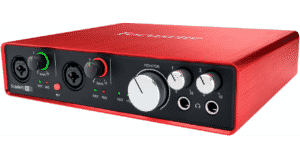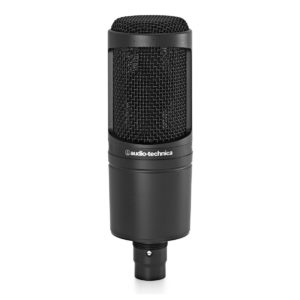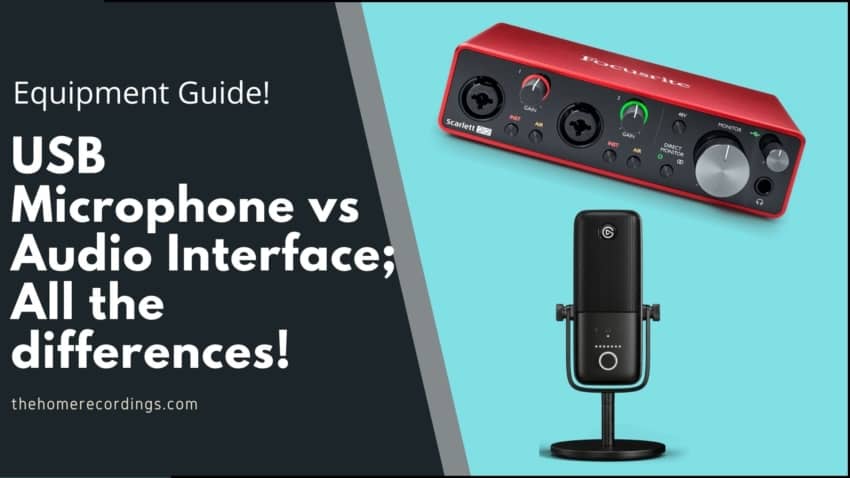Last updated on February 18th, 2022 at 09:36 am
With the rapid advancement in technology, the market is constantly throwing new options in our face, which is a good thing, but it can also get confusing real fast.
As soon as USB microphones became a thing, people started wondering whether or not to buy those or to get an Audio Interface and an XLR mic.
In this article, I will go over the difference between using an Audio Interface with XLR microphones, and USB microphones, and which one you should choose depending on your needs.
USB Microphone vs Audio Interface
USB microphones are simpler and easier to use because they don’t require any additional equipment to work since, but this comes at the cost of a lack in versatility, whereas with an Audio Interface, you can connect multiple XLR microphones to it and record as many inputs separately as the interface allows.
What all of this means is that USB microphones, while easier to use, are less versatile because -at least in most cases- they can only be used one at a time, but the whole setup is generally more affordable than getting an Audio Interface plus XLR cables and XLR microphones.
But on the other hand, Audio Interfaces generally allow for multi-tracking, meaning that you can record multiple simultaneous tracks, and they also make it easier to use different microphones since you only need to connect a new one using an XLR cable, and that’s it.
The question that you need to ask yourself is; if you want a plug and play microphone (USB) or if you want a setup that is capable of doing more than just a simple one-track recording, and that will allow for better future expandability?
In order to better understand which one to get, you should know what an Audio Interface is and how it works.
What is an Audio Interface?

The easiest explanation I can give is that an audio interface works as the translator between the microphone and the PC.
It takes the audio signal coming from the mic and translates it into something your computer can understand, and therefore, record.
Basically it converts the analog signal into a digital one.
And yes, your computer’s sound card is also an Audio Interface, but if I were you, I wouldn’t use it, especially if you want to get high-quality audio.
Read more about why this is in my article about the differences between the build-in sound card and an Audio Interface here.
Why get an Audio Interface?
In general, I would advise most people to go for an Audio Interface + XLR microphone setup, and here are the reasons for that;
Better Sound Quality
Audio Interfaces are designed to produce the highest audio quality possible. Of course, this depends on the quality of the preamps and the analog to digital conversion of the interface.
But in general, they do a better job at it than USB microphones.
XLR Cables are better than USB Cables
XLR Cables are designed to filter out any interference that the cable itself might pick up, and this is why you see 100-meter long XLR cables at live shows, since the sound quality will always come out perfect.
USB cables, on the other hand, are much more prone to picking up unwanted interference.
More Features
Not only can you connect and record one microphone per input on the interface, but every Mic/XLR input has a Gain knob to control the level of the signal for each input.
MIDI I/O is also featured on some audio interfaces, and it also has more output- and routing option than a USB mic.
Phantom Power Supply
Phantom power is required to power condenser microphones, usually 48v, and audio interfaces supply it in 99% of the cases.
Upgradeability
If you have a 4-input audio interface, for example, but only one mic, you can upgrade your setup by just getting more microphones.
This simply isn’t possible with USB microphones, since you would have to ditch the USB mic entirely and purchase an Audio Interface and XLR mics anyway to be able to record more than one track.
More Inputs and Output options (Generally)
Audio Interfaces allow you to connect XLR/TRS cables to it, basically as many as the number of inputs available on the Interface, which means that you could connect 8, 16 inputs, or even more depending on the interface, and these are not just for microphones but also guitars and Line level instruments.
They generally also have inserts on the back for effects, MIDI I/O for your MIDI keyboards or other MIDI devices, sends, ADAT ports for connecting external preamps, and some even have a reamping feature (these are audio interfaces strictly made for recording guitar).
Cons of an Audio Interface
- More expensive when combined with XLR microphone.
- Not as portable as USB microphone.
- Requires driver installation.
If you want to know more about the different audio interfaces available, check out this post I wrote about the best ones under $300.
What is a USB Microphone?

USB microphones are designed to be plug n’ play devices that you connect to your PC and that’s it, they are ready to record without the need of installing drivers or anything else.
In general, if you compare the exact same microphone model in both USB and XLR format, the USB microphone is more expensive mainly because it needs to do the analog to digital conversion that the audio interface usually does.
Additionally, a USB microphone will generally come with a lot more built-in features than an XLR mic, like a headphone output, headphone volume control, gain knob, headphone- and PC audio mix control, and more.
Basically, they come with similar features to the ones of an Audio Interface already built-in.
Why get a USB Microphone?
USB microphones are ideal for anyone who needs a simple device to record with, without the hassle of having to deal with drivers, loads of entangled cables, and for anyone who doesn’t need to record more than one simultaneous track.
Streaming/Online-Content
Most streamers and YouTubers use USB microphones.
The reason for this is that they only need to record that one input, and that’s it, and USB microphones make this extremely easy to accomplish.
My general mic recommendation for streamers is the Elgato Wave 3.
Consistency
Since USB microphones are plug and play on every major Operating System, no matter what computer you use them on, they will work.
Portability
If you need to travel, it’s much easier to take your laptop and a single USB mic, instead of having to carry the audio interface, XLR mic, XLR cable and power supply with you.
Cons of a USB Microphone
- No upgrade path (need to get a new one or purchase interface + XLR microphones.
- Some don’t have removable cables, so it the cables gets damaged, there goes the mic.
- Not as versatile as an audio interface.
Make sure to check this list of the 15 best USB Microphones currently available.
What is an XLR Microphone?

XLR Microphones require additional equipment to work, such as an audio interface or a mixer.
They come in all shapes and sizes and there area lot of different XLR microphone types; Condenser, Dynamic, Ribbon, etc.
XLR microphones are the ones used in music studios and live shows for the reason I mentioned earlier about XLR cables; they yield a better sounding recording than any other cable type.
This is why, if you truly want the best sound quality possible, go with an audio interface + XLR mic setup.
Recommendation; Audio Interface with XLR microphones, or USB Microphone?
If you still don’t know which way to go, here’s my recommendation:
I would only recommend a USB microphone if you’re absolutely certain that the need to upgrade to a better setup is not in your near future, since you would have to purchase an Audio Interface and XLR mics anyway, and the money you spent on the USB microphone would be wasted.
If you’re only recording one track, say for voice overs, YouTube videos, Streaming, etc., then absolutely, go with the USB microphone!
However, if you are a musician, podcaster, or anyone who needs to record high audio quality or multiple tracks at the same time, then get an audio interface, or even a mixer in the case of a podcast, with XLR microphones.
And, to make things even easier, here’s a pros & cons table for the different setups:
Pros & Cons about Audio Interfaces, XLR Microphones, and USB Microphones
| Equipment | Pros | Cons |
|---|---|---|
| Audio Interface + XLR Mic | Multi-track recording | More Expensive |
| Upgradeability | Cable Management | |
| More Features | Requires Phantom Power (A.I. usually supplies it) | |
| Increased I/O | Portability | |
| Better Sound | ||
| More Versatile | ||
| USB Microphone | Plug n’ Play | Records one track |
| More affordable | USB cables are worse than XLR | |
| No Phantom Power Required | Zero Upgradeability | |
| Consistent across every OS | ||
| Portability |
Conclusion
In my honest opinion, unless you really only need a single microphone, you should consider buying an interface.
Maybe just get one XLR microphone to begin with and then start upgrading and buying additional ones when you require them.
But if you want to get quality recordings, especially in a multi-track setting, then an Audio Interface will always beat a USB mic.
I Hope this was Helpful! hope you have a good one!
No, you don’t need an Audio Interface for a USB microphone to work since it’s designed to be used as a standalone unit.
In theory yes, because XLR cables are designed to remove outside interference and noise.
However, if the USB cable is short, there will be no audible difference in the quality of the sound.
While the components on some USB microphones might be identical to the one on their XLR counterparts, the sound quality isn’t the same.
This is not because of the microphones themselves, but because of the cables they use; XLR cables are designed to remove noise and interference, therefore the end result will be better.
